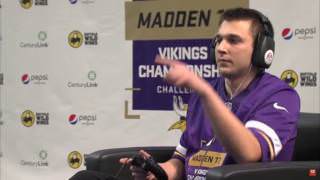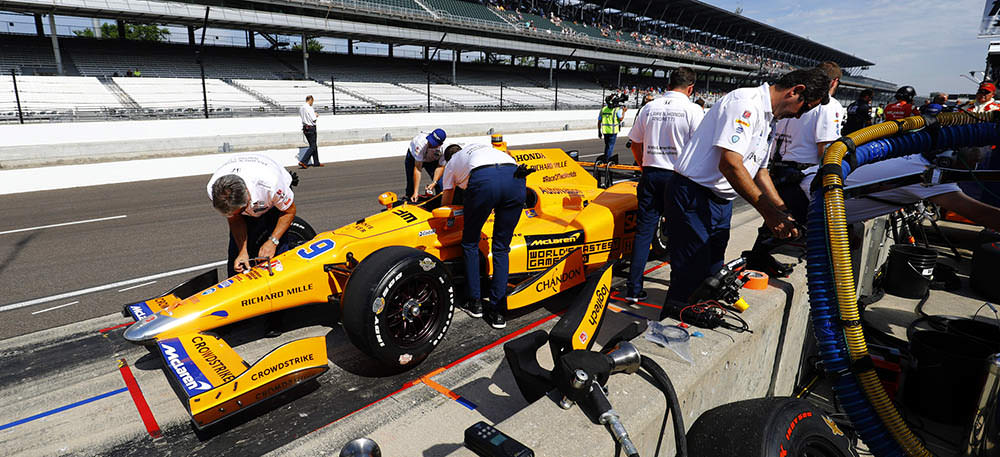The NFL is finally going all-in on esports. While Electronic Arts has been at the forefront of competitive gaming with its Madden NFL video game franchise for decades, and the game has been the centerpiece of esports through Madden Bowls and Madden Challenges for over 15 years, the NFL has committed all 32 clubs to the Madden NFL Club Championship this year. It’s part of the Madden NFL Championship Series (MCS), which EA launched last year.
The competition kicks off on August 23 with online qualifiers on Madden NFL 18 in the Madden Ultimate Team Champions mode. After registering online, gamers across the country can compete for a chance to represent their local NFL team in a competition that will fly out the top 32 players (one per team) to compete in the Madden NFL Club Championship Live Finals. That competition will commence at the NFL Pro Bowl in Orlando, Florida and culminate at the NFL Experience Driven by GMC in Minneapolis, Minnesota ahead of Super Bowl LII.
Madden Championship Series commissioner Matt Marcou told AListDaily that last year’s NFL Club Series competition, which featured eight NFL clubs, paved the way for the entire NFL to officially commit to esports for the first time.
“At EA, we learned that the feedback was positive and [NFL Club Series was] regarded as one of the coolest competitive offerings we’d put forth,” Marcou said. “That helped us want to push the program forward. Those eight clubs got deep insight into what competitive gaming is all about and how it’s a parallel to the competition they create with the NFL. Those clubs were over the moon about the series and that excitement served as a catalyst to encourage the rest of the clubs to follow suit. Most importantly, the clubs learned that this is a business they want to be in.”
With involvement from every club across the NFL, this is the largest competitive gaming commitment ever by a US professional sports league. The NBA and 2K will launch NBA 2K ELeague next year, and the inaugural season will feature 17 of 30 teams, with plans for all teams to join up eventually.
EA Sports is also expanding its FIFA esports offering this year. Marcou has seen esports emerge as a business unto itself.
“When we were running the Madden Challenge 10 years ago, it was experimental marketing,” Marcou said. “Now, thanks to changes in technology and in the market, instead of competitive gaming being a marketing initiative, it can be grown into a viable business outside of selling copies of the game.”
The Madden NFL Club Championship is one of three Madden NFL Championship Series EA Majors, the other two are the Madden NFL Classic on October 20-21 and the Madden NFL Challenge on December 15-16. EA hosted four EA Majors last year and the Madden Club Championship is replacing the Madden Bowl. EA Majors are the pinnacles of the Madden NFL Championship Series with only the top players qualifying. Additionally, the Madden NFL Championship Series purse has risen to $1.15 million for the season, up from $1 million in its inaugural season.

“The NFL is completely supporting us,” Marcou said. “We’re working hand-in-hand. The NFL has brought in an overall interest by bringing the clubs into this, as well as additional support to further this concept and bring it up to the EA Majors level.”
In a press release, NFL Commissioner Roger Goodell said, “Competitive gaming and esports are one of the most exciting ways to engage a larger, younger and digitally savvy NFL audience. Collaborating with EA to create the Madden NFL Club Championship presents a unique opportunity to capture the excitement of NFL action and the passion of our fans with competition that anyone can participate in.”
Marcou said each club decides how they want to activate in their own market. Last year the Patriots, Steelers, Jaguars and 49ers activated in their stadiums, while the Vikings held its esports event in the Mall of America and the Seahawks held theirs at the Seattle Pop Culture Museum.
“Last year, each club was allowed to bring in their athletes as they saw fit,” Marcou said. “With all 32 clubs involved now, we’ll see how each best figures out how to craft the experience for competitors and leverage their location and athletes. There is more opportunity for athletes at these competitions, but hopefully this opens up additional opportunities for EA as we’re running our Majors.”

Having 32 local markets invest in esports will open up new opportunities for local brands and sponsors, which is a similar approach Activision Blizzard is taking with its upcoming Overwatch League. Marcou said Madden creates more bite-sized opportunities for local club sponsors to get involved. Each club will have free range to integrate sponsors into their activities. Last year, the Patriots activated with Friendly’s ice cream and integrated that product into the competition, while Gillette, Buffalo Wild Wings and Snickers were also part of the event.
When it comes to national sponsorships, Marcou added that this competition creates more opportunity across the board.
“There’s no better opportunity than working with the official marketing partners of the NFL,” Marcou said.
While EA worked with McDonald’s last year for the Pro Bowl portion of the competition, Marcou said sponsors for this year have not yet been finalized. Nor have the digital and television partners for this season’s competition.





 Attendees were given an early look at The Crew 2 at E3, and Boukhelifa went into detail about how they presented the enormity of the world and the variety of vehicles at the event. He said that they started by showing a map of the US and zooming into New York City and out again. Then they did the same with Miami and other cities. That’s when audiences realized that the scope included Los Angeles, San Francisco, Las Vegas, St. Louis and everything in between.
Attendees were given an early look at The Crew 2 at E3, and Boukhelifa went into detail about how they presented the enormity of the world and the variety of vehicles at the event. He said that they started by showing a map of the US and zooming into New York City and out again. Then they did the same with Miami and other cities. That’s when audiences realized that the scope included Los Angeles, San Francisco, Las Vegas, St. Louis and everything in between.


